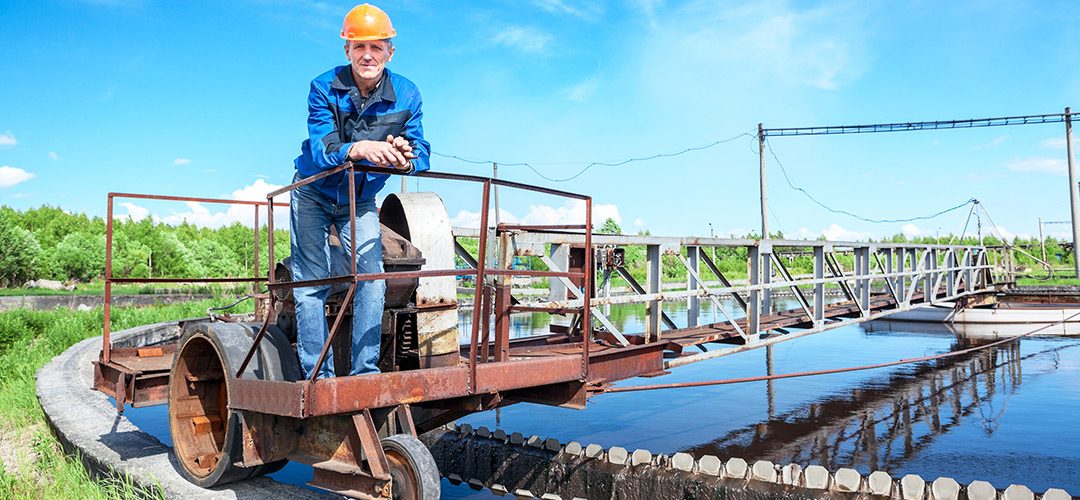“I LOVE scrubbing weirs”, said no operator EVER!
If you have phosphorus in your treatment plant (and who doesn’t?) you know that it can lead to algae growth, particularly in your clarifiers. Even if you treat with the traditional ferric or aluminum-based coagulants, enough phosphorus remains to give algae a foothold, threatening your compliance and coating your weirs with slimy green growth.
 The problem is ferric and aluminum-based coagulants don’t bind the phosphorus tightly enough. As the dissolved oxygen (DO) dips in the clarifier, phosphorus is re-released, and the quiet, sunlit conditions of the clarifier are perfect to support algae.
The problem is ferric and aluminum-based coagulants don’t bind the phosphorus tightly enough. As the dissolved oxygen (DO) dips in the clarifier, phosphorus is re-released, and the quiet, sunlit conditions of the clarifier are perfect to support algae.
For your operators, it is one dangerous maintenance issue. Operators can spend hours a week leaning precariously over railings scrubbing, scrubbing, scrubbing, trying to keep the weirs and troughs clear. It is dangerous and tedious work, and totally unnecessary.
By switching to rare earth elements, your operators can retire the scrub brush. Rare earth elements bind the phosphorus in a strong bond that isn’t impacted by changes in DO or pH. No phosphorus, no algae.
But the benefits don’t stop there.
Less Hazardous
We all know that working with ferric or alum is hazardous work, requiring a lot of personal protective equipment to be done safely. No one likes working in the ferric or alum area.
Rare earth elements are a lot less hazardous, with no fumes and requiring fewer precautions. And because the effective dosage is many times less than either ferric or aluminum-based treatments, you don’t need to replenish your supply of chemicals as often, again reducing the time your operators spend suited up.
Maintain alkalinity and reduce pH adjustment – make your nitrifiers happy
Other chemical consumption might also be reduced. Treating with ferric or aluminum-based coagulants consumes alkalinity, which is also essential to the health and function of your nitrifiers. If you have an ammonia limit, often imposed along with phosphorus limits, then you are probably adding more chemicals just to maintain your alkalinity. Because rare earth elements are less acidic, the impact on your alkalinity is greatly reduced, allowing you to cut back on chemical addition.
Less sludge, higher quality, lower costs
Sludge management is vastly improved as well, with less sludge produced. With traditional phosphorus treatments, sludge production increases by 25 to 40 percent, producing 12 to 16 mg/L of sludge for every mg/L of P removed. It is further complicated because these coagulants bind water within the floc, making it is difficult to dewater. Rare earth treatment reduces sludge volume. Because of the tight bond and a precipitate specific gravity of 4, settling is better with less bound and trapped water. This simplifies dewatering processes, producing a high-solids, low-water sludge for disposal. Some plants have seen belt filter press time reduced by as much as 80 percent. With less overall sludge and higher solids content, most plants save significantly on disposal costs.
Proud Operators
Yes, there are a lot of great reasons, both operational and economical, to make the switch to rare earth elements for phosphorus control. The most important may be the pride you and your operators will have at the gin-clear water spilling over your weirs. Many operators are surprised as during the first week of use, the clarity in the clarifiers improves to the point that they can see all the way to the sludge blanket. This and no scrubbing? That’s a win-win!
Ready to hang up your scrub brush? Contact us to learn more about how rare earth elements can make scrubbing a thing of the past.
Signup for occasional email updates at https://neowatertreatment.com/contact/get-updates/.


